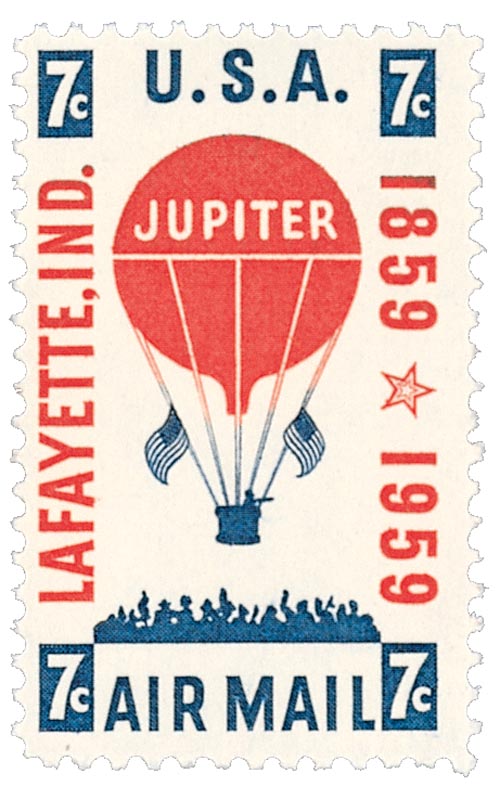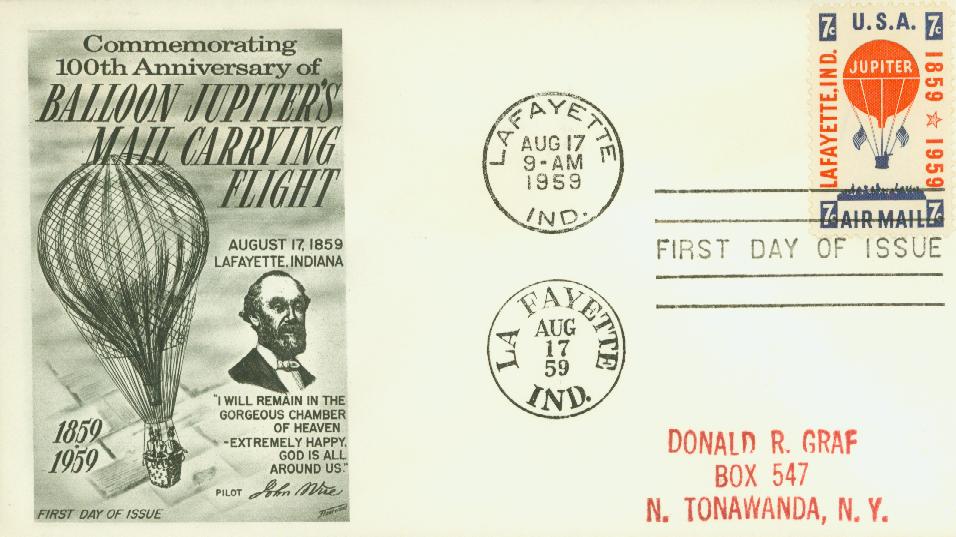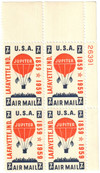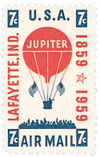
# C54 - 1959 7c Balloon Jupiter
1959 7¢ Balloon Jupiter
Printed By: Bureau of Engraving and Printing
Color: Dark blue and red
First US Airmail By Balloon

On August 17, 1859, the first airmail in the United States was carried by balloon in Indiana, from Lafayette to Crawfordsville.
In the past, there had been other attempts to carry mail by balloon, but none were sanctioned by the Post Office Department. This flight, arranged by John Wise, was in conjunction with the Lafayette postmaster Thomas Wood. Wise was a professional balloonist who had made over 230 balloon flights and hoped to set a record for the longest balloon flight.
Wise called his stunt a “transcontinental voyage,” as he aimed to carry the mail from Lafayette to New York City. Two days before the flight, a notice appeared in the local newspaper, reading “Prof. Wise will take a balloon mail from this city tomorrow. All persons who wish to send letters to the seaboard will place them in the Post office before twelve o’clock tomorrow, properly stamped, and directed “via Balloon.”
The flight was originally scheduled to take place on August 16 at 3:30 pm, but poor weather forced him to push the voyage back a day. So on the afternoon of August 17, a crowd of onlookers stood in the Lafayette town square in the 91-degree heat waiting for the historic flight. The local paper claimed it was “the largest ever assembled at Lafayette on any occasion,” and Wise said there were at least 20,000 people present.

Wise received 123 letters and placed them in a brass-locked mailbag marked “New York City.” The flight officially commenced at 2:00 that afternoon. However, the wind that day was blowing southwest, not east like he would have preferred. He reached an altitude of 14,000 feet and managed to travel 30 miles (in five hours). But he realized the voyage wasn’t going to work out and landed in Crawfordsville, Indiana. The letters were then placed on a train to complete their journey to New York. The local newspaper mocked Wise’s attempt, calling it “trans-county-nental.”
Wise tried the flight again a month later. This time he traveled nearly 800 miles to Henderson, New York. However, a storm forced him to crash land and the mail was lost. Wise would go on to fly observations balloons for the Union Army during the Civil War. However, he died in 1879 when his balloon crashed into Lake Michigan.

Of the 123 letters sent by balloon mail in 1859, only about 23 are known to still exist. This includes one in possession of the National Postal Museum, which you can view here.
1959 7¢ Balloon Jupiter
Printed By: Bureau of Engraving and Printing
Color: Dark blue and red
First US Airmail By Balloon

On August 17, 1859, the first airmail in the United States was carried by balloon in Indiana, from Lafayette to Crawfordsville.
In the past, there had been other attempts to carry mail by balloon, but none were sanctioned by the Post Office Department. This flight, arranged by John Wise, was in conjunction with the Lafayette postmaster Thomas Wood. Wise was a professional balloonist who had made over 230 balloon flights and hoped to set a record for the longest balloon flight.
Wise called his stunt a “transcontinental voyage,” as he aimed to carry the mail from Lafayette to New York City. Two days before the flight, a notice appeared in the local newspaper, reading “Prof. Wise will take a balloon mail from this city tomorrow. All persons who wish to send letters to the seaboard will place them in the Post office before twelve o’clock tomorrow, properly stamped, and directed “via Balloon.”
The flight was originally scheduled to take place on August 16 at 3:30 pm, but poor weather forced him to push the voyage back a day. So on the afternoon of August 17, a crowd of onlookers stood in the Lafayette town square in the 91-degree heat waiting for the historic flight. The local paper claimed it was “the largest ever assembled at Lafayette on any occasion,” and Wise said there were at least 20,000 people present.

Wise received 123 letters and placed them in a brass-locked mailbag marked “New York City.” The flight officially commenced at 2:00 that afternoon. However, the wind that day was blowing southwest, not east like he would have preferred. He reached an altitude of 14,000 feet and managed to travel 30 miles (in five hours). But he realized the voyage wasn’t going to work out and landed in Crawfordsville, Indiana. The letters were then placed on a train to complete their journey to New York. The local newspaper mocked Wise’s attempt, calling it “trans-county-nental.”
Wise tried the flight again a month later. This time he traveled nearly 800 miles to Henderson, New York. However, a storm forced him to crash land and the mail was lost. Wise would go on to fly observations balloons for the Union Army during the Civil War. However, he died in 1879 when his balloon crashed into Lake Michigan.

Of the 123 letters sent by balloon mail in 1859, only about 23 are known to still exist. This includes one in possession of the National Postal Museum, which you can view here.

















